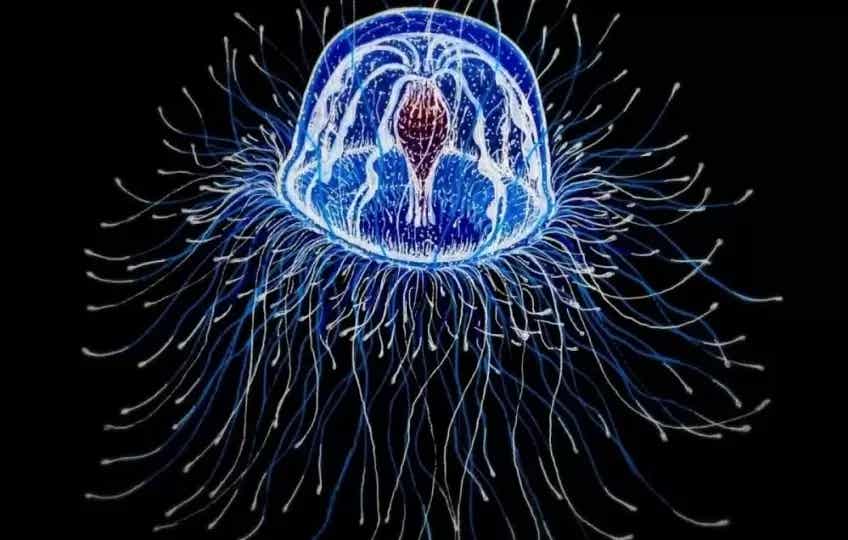This amazing jellyfish could help humanity unlock the secrets of eternal life
For millions of years, the oceans have harbored a creature with the potential to live forever.

For millions of years, the oceans have harbored a creature with the potential to live forever. Known as the 'immortal jellyfish' (Turritopsis dohrnii), this tiny, translucent being possesses a unique ability to avoid death, possibly allowing it to drift through the seas since before the dinosaurs went extinct around 66 million years ago.
Unlike any other known species, the immortal jellyfish can revert to its juvenile form when it grows old or sustains damage. This process is called transdifferentiation. This extraordinary process begins when the jellyfish reabsorbs its tentacles and transforms into a mass of undifferentiated cells. These cells then settle on the ocean floor and develop into a baby polyp. From this stage, the polyp can bud and produce genetically identical adult jellyfish, each no larger than a pinky nail.
This process, reminiscent of the fictional character Benjamin Button who ages in reverse, has earned the species the nickname 'Benjamin Button jellyfish'. First described by scientists in 1883, it wasn't until a century later that researchers accidentally discovered this species' ability to reset its life cycle while observing it in captivity.
Since this discovery, scientists have learned that colonies of immortal jellyfish kept in laboratories can revert to their polyp stage and restart their life cycle up to ten times within two years. This unique ability to rejuvenate after sexual reproduction makes the immortal jellyfish 'biologically immortal.'
Originally thought to have originated in the Mediterranean Sea, the immortal jellyfish is now found in oceans worldwide. Despite its widespread presence, much about its longevity remains a mystery. In 2022, genomic research revealed that this jellyfish possesses over a thousand genes related to aging and DNA repair. Understanding these genes could unlock the cellular mechanisms behind its ability to escape death.
In 2019, scientists compared the genetic expression of cells from an immortal jellyfish polyp to those of a newly-formed adult medusa, complete with tentacles and a bell. They found notable differences in cell function, suggesting that specialized cells are being reprogrammed, essentially resetting the biological clock.
Related Stories
It's important to note that while the immortal jellyfish can rejuvenate, it is not invincible. These jellyfish can still die from injuries or starvation. However, their ability to potentially live indefinitely sets them apart from all other known organisms.
"The lesson of Turritopsis is profound," writes zoologist Ferdinando Boero, who led the lab that first discovered the jellyfish's immortal capabilities in the 1990s. "…if we explore biodiversity, we will find exceptional organisms that do exceptional things."
Implications for human aging and more
Aging research. The study of Turritopsis dohrnii offers intriguing possibilities for human aging research. By identifying and understanding the genes that allow the jellyfish to revert to a younger state, scientists hope to uncover new insights into the aging process in humans. This knowledge could lead to breakthroughs in age-related diseases and potentially extend the human lifespan.
Cancer research. The process of transdifferentiation in Turritopsis dohrnii involves significant cellular changes and regulation. Understanding how these cells avoid the uncontrolled proliferation characteristic of cancer could provide new perspectives on cancer biology. Investigating how the jellyfish's cells maintain their integrity and avoid malignant transformation despite undergoing extensive cellular reprogramming could inspire novel approaches to cancer treatment.
Cellular Reprogramming. At the heart of Turritopsis dohrnii’s immortality is its ability to reprogram its cells. This process is akin to what scientists achieve in the lab with induced pluripotent stem cells (iPSCs), which can be generated from adult cells and reprogrammed to become any cell type. Understanding how the jellyfish naturally achieves this could lead to more efficient and effective methods for cell reprogramming, potentially revolutionizing regenerative medicine and therapies for degenerative diseases.
The next steps in research involve pinpointing the specific genes and mechanisms that enable the jellyfish to rejuvenate. Scientists aim to compare these findings with the genetic makeup of closely related species that do not share the same regenerative capabilities. This comparative approach could reveal critical differences and provide a deeper understanding of cellular aging and regeneration.
While much remains to be discovered about this remarkable creature, its existence challenges our understanding of life and longevity. As research progresses, the secrets held by Turritopsis dohrnii may one day pave the way for revolutionary advancements in medicine and our quest for a longer, healthier life.
For more science news stories check out our New Discoveries section at The Brighter Side of News.
Note: Materials provided by The Brighter Side of News. Content may be edited for style and length.
Like these kind of feel good stories? Get the Brighter Side of News' newsletter.
Joshua Shavit
Science & Technology Writer | AI and Robotics Reporter
Joshua Shavit is a Los Angeles-based science and technology writer with a passion for exploring the breakthroughs shaping the future. As a contributor to The Brighter Side of News, he focuses on positive and transformative advancements in AI, technology, physics, engineering, robotics and space science. Joshua is currently working towards a Bachelor of Science in Business Administration at the University of California, Berkeley. He combines his academic background with a talent for storytelling, making complex scientific discoveries engaging and accessible. His work highlights the innovators behind the ideas, bringing readers closer to the people driving progress.



